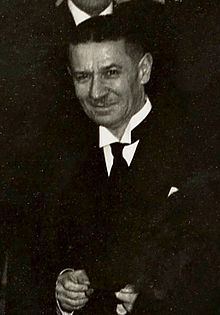Name Henri Coutard | Died March 16, 1950 | |
 | ||
Henri Coutard (27 April 1876 – 16 March 1950) was a French pioneer in radiation oncology and is credited with establishing radiotherapy as a clinical discipline. He performed early work on the therapeutic use of Radium emanation.
Contents
Henri Coutard was born in Marolles-les-Braults in Sarthe, France in 1876 and died of a cerebral hemorrhage in Le Mans, France in 1950. He began his education in Caen and graduated in 1902 from the University of Paris. Coutard was stricken with pulmonary tuberculosis and so he moved to the alpine area of Jura and took up the hobby of mountaineering. Coutard practiced medicine during this recovery period. He then returned to Paris and started his researches with the recently discovered Radium at the Laboratoire d’Essais of Gif in the banlieue of Paris. In 1912 Coutard publish his first work on the therapeutic use of Radium emanation.
The Radium Institute
During World War I Coutard served in the medical corps that utilized one of the first mobile radiological units. In 1912, he helped to organize the biomedical services of the Radium Institute. To assist the war effort, Coutard sought assistance from Claudius Regaud, Alexandre Lacassagne, John Joly, R. Ferroux (physicist), Octave or C. Monod, and Jean Louis Roux-Berger (surgeon).
In 1919 this group became the nucleus for the formation of the Radium Institute of the University of Paris. He studied experimental radiophysiology and radiodiagnosis and practiced radiotherapy using a solitary X-ray system with interchangeable tubes.
In 1922, he described the mucous membrane reaction which he named radioepithelitis.
He originated the radiographic study of the larynx Refusing to accept the theoretical limitations of Regaud's fractionation, Coutard ventured to extend the daily irradiation of patients to periods of several weeks. The results that Coutard achieved in the treatment of cancer of the larynx attracted attention from all over the world. This technique would become known as the protracted-fractional method. The contributions from Coutard are now part of the routine practice of radiotherapy.
In the photograph often referred to as the "Most Famous Cancer Researchers in the World," pictured are from left to right:
Note regarding Photograph: at the time the photograph was taken, C. C. Little headed the Roscoe B. Jackson Laboratory, Bar Harbor, Maine; Edgar Allen was professor of anatomy at Yale University Medical School; and Andervont was with the U.S. Public Health Service. Macklin was associate professor of Histology and Embryology at University of Western Ontario, and later served as president of the American Society of Human Genetics. Leiv Kreyberg taught at the University of Oslo; Gioacchino Failla was then working at the Cancer Memorial Hospital of New York City; and Coutard was chief of the department of x-ray therapy for cancer at the Radium Institute, University of Paris.
During World War I Coutard served in the medical corps that utilized one of the first mobile radiological units. In 1912, he helped to organize the biomedical services of the Radium Institute. To assist the war effort, Coutard sought assistance from Claudius Regaud, Alexandre Lacassagne, John Joly, R. Ferroux (physicist), Octave or C. Monod, and Jean Louis Roux-Berger (surgeon).
Work in the United States
In 1937 Coutard went to the United States to work with supervoltages at the California Institute of Technology Kellogg Radiation Laboratory. He then went to the Chicago Tumor Institute to study the application of short, concentrated treatments on cancer of the larynx. In 1941 Coutard accepted the position as Director of Research at the Penrose Cancer Hospital of Colorado Springs (Penrose Tumor Clinic) in the mountains of Colorado Springs. He had received an invitation from the El Pomar Foundation on behalf of the Sisters of Charity.
Return to France
In 1949 Coutard returned to France and published his last monograph. He died in 1950 at his childhood home after a cerebral hemorrhage in Le Mans.
